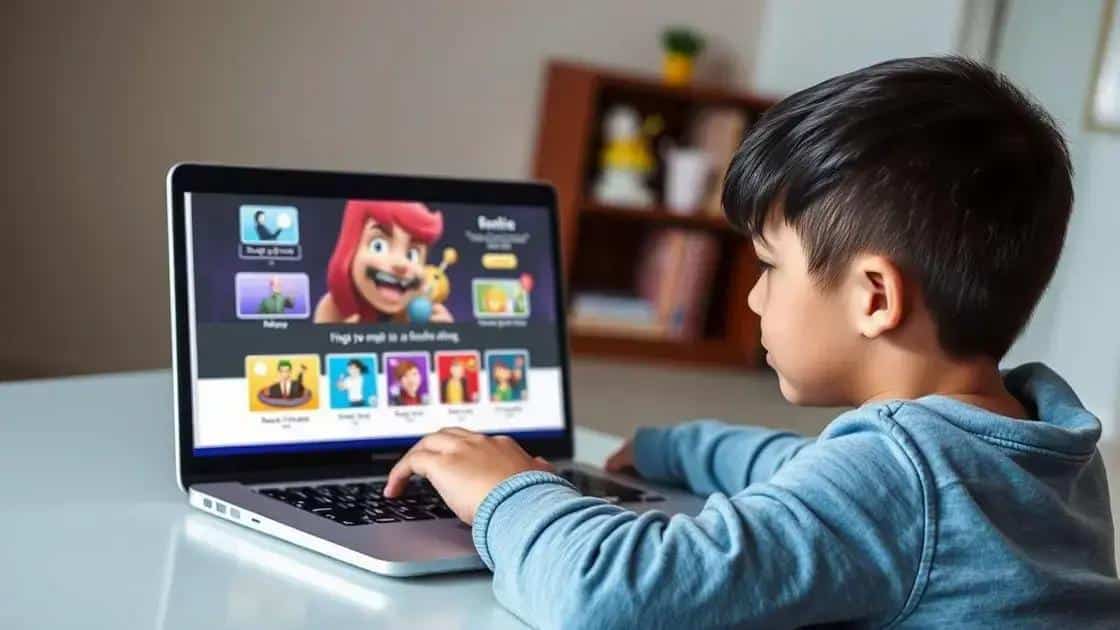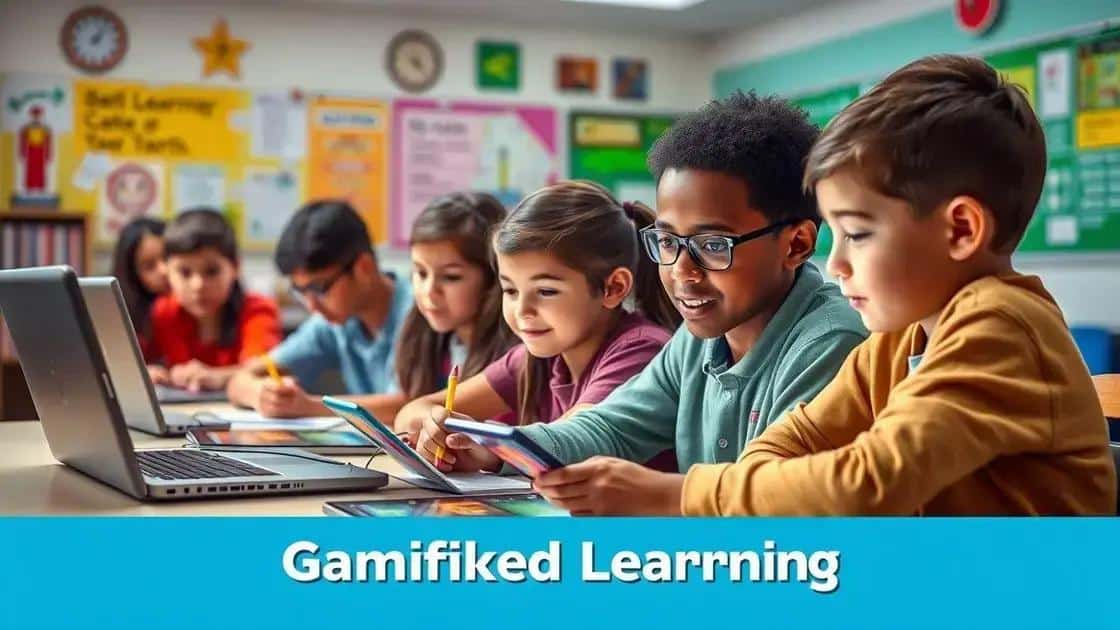Insights on gamified learning platforms: what you need to know

Gamified learning platforms enhance engagement and retention by incorporating game mechanics like rewards, challenges, and competition, making education more interactive and enjoyable for students.
Insights on gamified learning platforms can really change the way we think about education and engagement. Have you ever wondered how games can make learning more enjoyable and effective? In this article, we’ll dive into how these innovative platforms work.
Understanding gamified learning and its importance
Understanding gamified learning and its importance is essential in today’s educational landscape. This approach blends traditional learning with game elements to enhance student engagement. By applying game mechanics in educational settings, we can foster a more enjoyable and interactive learning experience.
What is Gamified Learning?
Gamified learning involves integrating game design elements into non-game contexts. This means using features like points, badges, challenges, and leaderboards to motivate learners. Here are a few key aspects:
- Motivation: Game mechanics can significantly boost motivation by making learning fun.
- Engagement: Interactive challenges keep learners involved and interested.
- Feedback: Instant feedback helps learners track their progress and fosters improvement.
When learners are part of a game-like environment, they are more likely to participate actively. Imagine solving a math problem that rewards you with points or badges! It’s this type of excitement that comes from gamified learning.
The Importance of Gamified Learning
The importance of gamified learning cannot be overstated. Research shows that integrating play into education leads to better retention of information. Students remember concepts longer and can apply knowledge more effectively when they learn through engaging activities.
Moreover, gamification caters to different learning styles. For example, visual learners might enjoy graphics and animations, while auditory learners benefit from sounds and music in the learning process. Here are some benefits:
- Enhances retention: Students tend to remember lessons taught in a fun way.
- Promotes collaboration: Many gamified platforms encourage teamwork and peer interaction.
- Develops critical thinking: Challenges require learners to think critically and solve problems creatively.
Understanding how gamified learning works provides invaluable insights. As educators and learners adapt to these methods, they pave the way for a more innovative and effective educational experience.
Key benefits of using gamified platforms

The key benefits of using gamified platforms extend far beyond simple engagement. These platforms can transform traditional education methods, making learning enjoyable and effective. When learners are exposed to game-like elements, they often feel more motivated to participate in their learning journey.
Enhanced Engagement
One major benefit is enhanced engagement. Gamified platforms capture students’ attention in a way that textbooks often cannot. By introducing elements like quests and challenges, learners immerse themselves in activities that keep them focused. Engaged students are likely to spend more time on their tasks, leading to a better understanding of the material.
- Interactive Learning: Activities are designed to be fun and interactive, encouraging collaboration.
- Real-Time Feedback: Learners receive immediate feedback, helping them understand their progress.
- Goal Achievement: Setting clear goals motivates learners to achieve milestones.
Furthermore, gamified learning can cater to different learning styles. Visual learners may appreciate colorful graphics, while kinesthetic learners enjoy hands-on activities. This inclusive approach helps ensure that all students can benefit.
Improved Retention of Information
Another essential advantage is improved retention of information. When students learn through play, they often remember concepts longer. Playing a game encourages repetition in a fun way, reinforcing learning while avoiding monotony.
For instance, a student may struggle with math problems in class. However, if the same problems are presented in a game, they may grasp the concepts quicker and remember them long after. This learning method not only enhances comprehension but also builds confidence.
- Reinforced Learning: Game mechanics promote repetition, solidifying knowledge.
- Reduced Anxiety: A fun environment decreases anxiety often associated with traditional tests.
- Encourages Exploration: Students become more willing to explore new topics.
The key benefits of utilizing gamified platforms are clear. As more educators recognize these advantages, the landscape of learning is shifting towards a more dynamic and effective model. Creating a fun and inclusive environment is key to fostering a love for learning.
Best practices for implementing gamified learning
When considering the best practices for implementing gamified learning, it’s essential to focus on creating an engaging and supportive environment. Establishing clear goals and understanding your audience is key to success. This approach ensures that the gamified elements resonate with learners.
Identify Learning Objectives
Before diving into gamification, identify the specific learning objectives you wish to achieve. Setting clear goals helps in designing relevant activities. These objectives can guide the development of game mechanics that align with your educational aims.
- Define Skills: What skills should learners develop? Focus on these when creating challenges.
- Set Performance Metrics: Decide how you will measure success, such as through assessments or observations.
- Know Your Audience: Understand the interests and needs of your learners to tailor the experience.
Tailoring gamified learning to your audience increases student motivation. When learners can relate to the content, they’re more likely to engage deeply.
Incorporate Game Mechanics
Incorporating game mechanics is crucial to successful gamified learning. Elements like points, levels, and badges can create a competitive yet fun atmosphere. This encourages participation and rewards effort.
For instance, a point system can motivate students to complete tasks and earn recognition. Badges can serve as symbols of achievement, boosting confidence and encouraging continued effort. Consider implementing:
- Challenges: Create tasks that learners must complete to earn rewards.
- Leaderboards: Display rankings to foster healthy competition among students.
- Feedback Loops: Provide immediate feedback to help learners improve.
The right mix of game mechanics can enhance the learning experience. This not only keeps students engaged but also promotes a sense of accomplishment as they progress through challenges.
Foster a Supportive Community
Building a supportive community enhances the gamified learning experience. Collaboration among students can enrich learning and foster deeper connections. Encouraging teamwork enables students to support one another, which is particularly valuable in a gamified setting.
Group projects and cooperative challenges facilitate collaboration, making learning an enjoyable shared experience. Community aspects can include:
- Team Challenges: Create group tasks that require collaboration.
- Discussion Forums: Use online platforms for learners to discuss ideas and strategies.
- Peer Feedback: Encourage students to help each other through constructive critiques.
By following these best practices, educators can effectively implement gamified learning, creating an engaging, impactful, and supportive environment for all learners.
Examples of successful gamified learning platforms

There are many examples of successful gamified learning platforms that have transformed education in engaging ways. These platforms illustrate how incorporating game mechanics can enhance the learning experience, making it both fun and effective.
Kahoot!
Kahoot! is a popular tool used in classrooms around the world. This platform allows teachers to create interactive quizzes that students can participate in real-time. The game-like format keeps students excited and engaged. Students earn points for correct answers, and the competitive element encourages everyone to join in and do their best.
- Real-time interaction: Students respond to questions on their own devices.
- Visual engagement: Bright colors and games capture attention.
- Flexible topics: Teachers can create quizzes on any subject.
With Kahoot!, students actively participate and learn through competition, which makes studying a more enjoyable experience.
Classcraft
Classcraft takes a different approach by turning the classroom into a role-playing game. Students create characters and work together to complete quests and overcome challenges. This encourages collaboration among peers and fosters a sense of community. As students progress, they earn rewards that can help them in the game and in class.
- Character development: Students personalize their characters.
- Team-based gameplay: Groups collaborate to achieve goals.
- Behavior tracking: Positive behaviors earn in-game rewards.
The narrative and teamwork aspects of Classcraft encourage students to support one another, making learning a collective adventure.
Duolingo
Duolingo is a language-learning platform that uses game mechanics to teach new languages in a fun way. Users complete lessons that resemble games, earning points and leveling up as they progress. The use of streaks and daily goals encourages daily practice and helps reinforce learning.
- Daily goals: Users are motivated to practice regularly.
- Interactive lessons: Engaging exercises keep learners interested.
- Instant feedback: Users know right away if they got answers correct.
With Duolingo, learners feel motivated to continue their studies due to the enjoyable and immersive gameplay.
These examples of successful gamified learning platforms show how effective this approach can be in enhancing students’ educational experiences. By integrating games into learning, educators help students stay engaged and motivated to achieve their goals.
Incorporating gamified learning platforms into education creates a dynamic and engaging environment for students. These platforms not only promote interaction and collaboration but also make learning enjoyable. Teachers can enhance student motivation by setting clear objectives and using game-like mechanisms such as rewards and challenges. As we’ve seen with successful platforms like Kahoot!, Classcraft, and Duolingo, the benefits of gamification are clear. Students are more engaged, motivated, and likely to retain information when learning in a fun, interactive way. Embracing this approach can lead to a more enriching educational experience for everyone involved.
FAQ – Frequently Asked Questions about Gamified Learning Platforms
What are gamified learning platforms?
Gamified learning platforms use game design elements to enhance educational experiences, making learning more engaging and fun for students.
How do gamified platforms enhance student engagement?
They incorporate interactive challenges, rewards, and competition, which motivate students to participate actively and maintain interest in their learning.
Can gamified learning improve knowledge retention?
Yes, learning through gamification encourages repetition in a fun context, helping students remember information longer.
What are some examples of successful gamified learning platforms?
Notable examples include Kahoot!, Classcraft, and Duolingo, each using unique mechanics to engage learners in different subjects.





